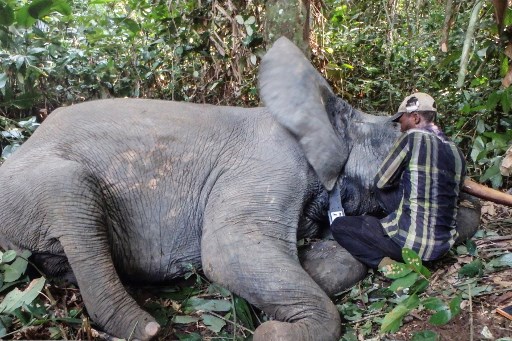Ever tried to put a GPS real-time tracking collar on a five-tonne animal?
Well in Gabon conservationists have begun trying to use the devices on elephants; tracking and drugging the animals, before attaching the high-tech gadgets in a bid to stop poachers and ivory trafficking.
But it is not a simple task.
Each operation needs around five to seven men, including a vet, scouts and trackers, to guide the group through dense jungle and locate the often shy animals.
“They have to fit one or two GPS collars a day,” says Jean-Baptiste Squarcini, general secretary of Gabon’s national parks agency (ANPN).
“It’s very dangerous with our men repeatedly being charged by elephants.”
Once an elephant is spotted, a vet will move forward and use a compressed air rifle to fire a dart carrying etorphine: a semi-synthetic opioid more than 1,000 times more powerful than morphine.
“Too heavy a dose will kill the elephant. Too weak, it can escape. You have to get it right,” Squarcini notes.
“When it has been hit, you have to be ready to avoid a possible charge.”
Like a good hangover
After the elephant is asleep on the ground, the team carry out a health check and take samples while a giant black GPS collar is fitted.
The whole process takes around 10 minutes and the team then take cover, sometimes climbing up trees, before the animal is woken up with an antidote.
“The animal wakes, a little stunned, like from a good hangover,” smiles Squarcini.
South African veterinarians helped local colleagues fit 20 elephants with GPS collars last December in the Mwagna and Ivindo parks in north east Gabon.
The neighbouring Minkebe park will join the collar campaign during February.
For 45 days, an ANPN team led by South African conservationist Peter Morkel will travel through the forest covering about 20 kilometres (12 miles) a day.
Danger zones
The wanderings of some of the tagged elephants — including Junior, Boniface, Syndie, Kate and Zara — appear on a map in ANPN operation centre in the capital Libreville.
A large screen shows live satellite input from the Global Positioning System (GPS) collars, which displays a warning if an animal gets too close to an inhabited area or does not move for too long and may be in danger.
“It enables us to see when they move into danger zones, places where we regularly find carcasses and we know that poachers are present,” explains Parfait Ndong Ondo, one of the centre’s spotters.
One elephant, “Patrice”, is being closely watched as he has strayed out of Ivindo national park and is moving towards a railway line.
“He could destroy the harvest or stray into an area where poachers are active,” says Squarcini.
“We know that we have to intervene.”


